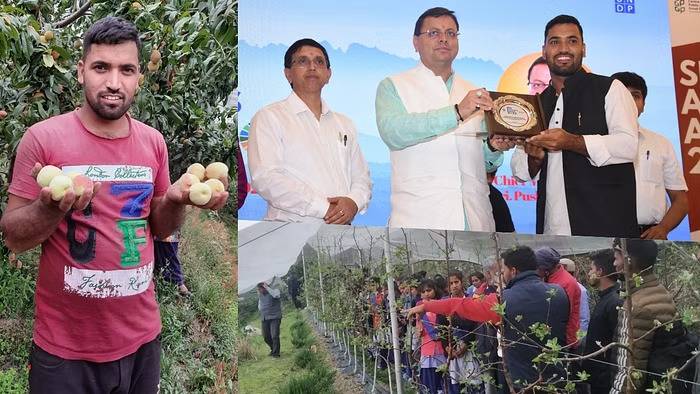
Somewhere in Chamroha village of Uttarakhand, Jagmohan Rana's apple orchards tell a tale of transformation. Departing from conventional practices, Rana's adoption of the Ultra High-Density Planting Model has turned his once modest orchards into a thriving business, earning him close to 10 lakhs annually. This is the saga of a visionary farmer rewriting the rules of agriculture with modern methods.
Rana is a qualified youth with a master's degree and a B.Ed. Inspired by his father, he started to work in the field of Agriculture to develop self-employment in the hills. He provides training to the youth to generate self-employment and is also awarded for his work at Block, District, and State levels.
Modern Agriculture
Eight years ago, Rana, a traditional farmer with a penchant for apple cultivation, decided to embrace modern agricultural practices. Armed with 40 nalis (a traditional unit of measurement) of arable land, equivalent to nearly 2 acres, he started a journey to revolutionise his farming techniques. The adoption of the Ultra High-Density Planting Model allowed him to maximise his yield, planting approximately 250 apple saplings on just 4 nalis of land.
Rana explains, "The conventional ways were limiting. Modern methods allowed me to cultivate more plants on less land, significantly boosting productivity."
Quality Triumphs over Quantity
Rana's focus shifted from merely increasing yield to enhancing the quality of his produce. Despite the smaller size of the apples, weighing approximately 6 to 7 kilograms per tree, the superior taste and appearance translated into higher market prices. This strategic shift has not only augmented his financial gains but also established his orchards as a source of premium-quality apples.
Rana emphasises, "Quality matters. The taste and appearance of our apples speak for themselves, bringing better returns."
Beyond Apples
Rana's orchards are not limited to apples alone. In addition to his thriving apple groves, he has diversified into cultivating plums, peaches, pears, and apricots, resulting in an annual yield of 70 to 80 crates. This diversification not only adds a layer of resilience to his agricultural portfolio but also contributes significantly to his income.
Beyond fruits, Rana's commitment to sustainable farming is evident in his cultivation of medicinal crops like tulsi, rosemary, lemon grass, and stevia. The integration of these crops not only promotes biodiversity but also positions Rana as a forward-thinking farmer in the local agricultural landscape.
Financial Sustainability
Rana's meticulous planning extends to the financial sustainability of his agricultural venture. Approximately 70 percent of his earnings remain as profit after accounting for cultivation and processing expenses. By actively participating in local markets and engaging directly with traders, he has sidestepped the uncertainties associated with traditional mandis.
The integration of his produce into local markets and the establishment of the 'Yamuna Valley' brand for processed goods underscore Rana's commitment to market dynamics. He notes, "Direct sales and brand establishment have been instrumental in ensuring consistent earnings and market presence."
















